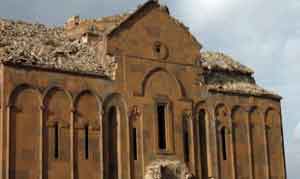U.S. Congress Tells Turkey To Safeguard Christian Heritage
 In a resolution hailed by Armenian-American groups but criticized by Ankara, the U.S. House of Representatives urged Turkey late on Tuesday to respect religious freedom and return Armenian and other Christian worship sites to their “rightful owners.” The resolution drafted by two California lawmakers, Republican Ed Royce and Democrat Howard Berman, is virtually identical with legislation approved by the House Foreign Affairs Committee in July. It said the Turkish authorities should “end all forms of religious discrimination” of the country’s Christian minorities.
In a resolution hailed by Armenian-American groups but criticized by Ankara, the U.S. House of Representatives urged Turkey late on Tuesday to respect religious freedom and return Armenian and other Christian worship sites to their “rightful owners.” The resolution drafted by two California lawmakers, Republican Ed Royce and Democrat Howard Berman, is virtually identical with legislation approved by the House Foreign Affairs Committee in July. It said the Turkish authorities should “end all forms of religious discrimination” of the country’s Christian minorities. “Despite Prime Minister [Recep Tayyip] Erdogan's recent claims of progress on religious freedom, Turkey’s Christian communities continue to face severe discrimination,” Royce said after the House vote.Berman spoke of “Turkey's disturbing, persistent failure to respect the ancient Christian heritage of Anatolia.”
“Turkey should take immediate steps to restore all confiscated church property and allow full freedom of worship and religious education for all Christian communities,” he said, according to the Armenian National Committee of America (ANCA).
Ankara was quick to denounce the resolution. The official Anatolia news agency quoted the Turkish ambassador in Washington, Namik Tan, as calling it “unfair and unjustified.”
In contrast, the two main Armenian-American advocacy groups welcomed the measure. They both have lobbied hard for its passage. “We commend this bipartisan measure in support of religious freedom in Turkey,” said Bryan Ardouny, executive director of the Armenian Assembly of America.“Today's vote - over opposition from Turkey's Prime Minister Recep Erdogan and, sadly, even our own American President's Administration - represents a powerful victory for religious freedom,” read a separate statement by Ken Hachikian, the ANCA chairman. Hachikian said the resolution underlined the need for “the return of thousands of stolen Christian churches properties and holy sites.”
The eastern regions of modern-day Turkey were once home to hundreds of Armenian churches built there since the early Middle Ages. The vast majority of them were destroyed, ransacked or turned into mosques during and after 1915 slaughter of an estimated 1.5 million Armenians in the Ottoman Empire.Royce rebuked Ankara on Tuesday for continuing to vehemently deny that the mass killings and deportations constituted genocide.One of the few surviving examples of the ancient Armenian civilization in eastern Turkey, the 10th century church of Surp Khach (Holy Cross), was renovated by the Turkish government in 2007. The church perched on the legendary Akhtamar island in Lake Van saw its first mass in nearly a century in September last year. Turkey -- Devlet Bahceli, leader of the Nationalist Movement Party or MHP (R), and provincial party chiefs offer their Friday prayers at an abandoned church-turned-mosque in the historical site of Ani in the Kars province.
The authorities in Ankara have so far resisted calls for the church’s formal return to Turkey’s small Armenian community. The Akhtamar temple currently has the status of a state museum.The Turkish government caused outrage in Armenia and its worldwide Diaspora later in 2010 when it allowed Turkish nationalists to perform Muslim prayers in another historic Armenian church, the 11th century Holy Virgin Cathedral. The imposing cathedral is located at the ruins of Ani, the capital of a medieval Armenian kingdom. It lies less than one kilometer from the Turkish-Armenian border. Built by an Armenian royal dynasty in 1001 A.D., the cathedral has for centuries been regarded as a masterpiece of medieval Armenian architecture. According to official Turkish sources, Seljuk Sultan Alparslan converted it into a mosque when he captured Ani and surrounding regions in 1064. The Seljuks were driven out of much of historical Armenia a century later.
Copyright (c) 2011. RFE/RL, Inc. Reprinted with the permission of Radio Free Europe/Radio Liberty, 1201 Connecticut Ave., N.W. Washington DC 20036. Original article: http://bit.ly/rz8OtG
Last modified onSaturday, 06 May 2017 10:07
Latest from Admin TOA
- Fat Sal’s Italian Specialties Welcomes Customers in Bayville, NJ with a Renewed Concept
- FFD Wood LLC Delivers Custom Woodwork Solutions from Long Island
- A Tax Expert in the U.S. Tax World: An Interview with Samet Oynamıs
- Announcing the 2025 Edition of the 100 Most Influential Turkish Americans
- CEO Club New York Networking Night Stands Out with the Lamborghini Experience









